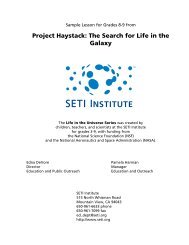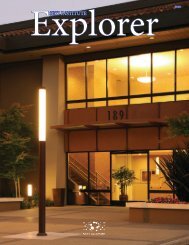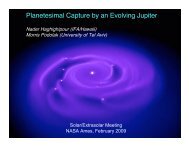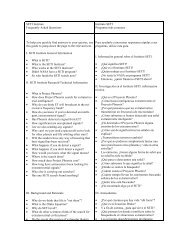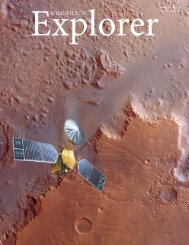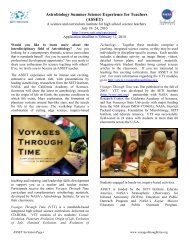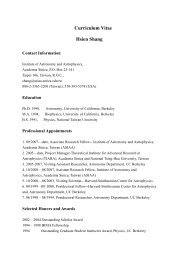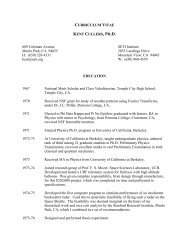Inside the Boardroom with Alan Bagley - SETI Institute
Inside the Boardroom with Alan Bagley - SETI Institute
Inside the Boardroom with Alan Bagley - SETI Institute
You also want an ePaper? Increase the reach of your titles
YUMPU automatically turns print PDFs into web optimized ePapers that Google loves.
Astrobiology<br />
Perseids<br />
© Wally Pacholka/ www.astropics.com<br />
Tune In!<br />
Are We Alone<br />
<strong>the</strong> <strong>SETI</strong> <strong>Institute</strong>’s<br />
Weekly Science<br />
Radio Program<br />
by Peter Jenniskens<br />
For as long as records exist, <strong>the</strong><br />
Perseid meteor showers have always<br />
been strong. This summer’s<br />
Perseid shower will be exceptional.<br />
The moon is mostly out of<br />
<strong>the</strong> way later in <strong>the</strong> night, and higher-thannormal<br />
activity rates are expected over <strong>the</strong><br />
United States.<br />
The Perseid shower’s parent body, comet<br />
109P/Swift-Tuttle, is notable in being a<br />
comparatively huge comet in an orbit that<br />
passes close to Earth’s orbit frequently. It<br />
measures 24 - 31 kilometers in diameter, 2<br />
to 3 times <strong>the</strong> size of comet Halley, and is so<br />
big that <strong>the</strong> continuous ejection of water vapor<br />
and dust during its approach to <strong>the</strong> Sun<br />
does not move <strong>the</strong> comet much off course.<br />
It has spewed dust for at least 5,000 years<br />
and most likely thirty times longer. It has<br />
built a massive meteoroid stream, most of<br />
which is located just outside of Earth’s orbit.<br />
Earth passes through <strong>the</strong> outer regions<br />
of that stream in July, and hits <strong>the</strong> center on<br />
August 12. At that time, <strong>the</strong> annual Perseid<br />
shower peaks at 80 meteors per hour under<br />
ideal circumstances (no clouds or moon,<br />
dark sky, stars of magnitude +6.5 just visible).<br />
When comet 109P/Swift-Tuttle was<br />
rediscovered in 1992, scientists noticed in<br />
alarm that a delay of 17 days in <strong>the</strong> next<br />
projected return of <strong>the</strong> comet in 2126 could<br />
cause it to collide <strong>with</strong> Earth. That fear dissipated<br />
when <strong>the</strong> orbit was recomputed<br />
using data from sightings in 188 A.D. and 69<br />
B.C. The more precise orbit has <strong>the</strong> comet<br />
approach Earth in 2126 to <strong>with</strong>in only 23<br />
million kilometers, but <strong>the</strong>re’s no danger of<br />
us being hit. In September 4479, <strong>the</strong> comet<br />
will approach Earth even closer, to <strong>with</strong>in<br />
about 6 million kilometers. It will <strong>the</strong>n be<br />
as bright as Jupiter (-2.1 magnitude) in<br />
<strong>the</strong> sky.<br />
The dust released will spread along <strong>the</strong><br />
comet orbit because some dust grains make<br />
wider orbits than o<strong>the</strong>rs and return later.<br />
When Earth encounters <strong>the</strong>se dust trails,<br />
a meteor storm may be observed. But only<br />
if <strong>the</strong> very narrow trail is steered smack in<br />
Earth’s path by perturbations of <strong>the</strong> planets.<br />
Most dust does wander far from <strong>the</strong> comet,<br />
which is why <strong>the</strong> best showers are observed<br />
in <strong>the</strong> years following when <strong>the</strong> comet returns,<br />
while lesser outbursts occur when<br />
dust fur<strong>the</strong>r along <strong>the</strong> comet orbit wanders<br />
into Earth’s path.<br />
The next big shower is not expected until<br />
<strong>the</strong> next return of <strong>the</strong> comet. For now,<br />
a nice outburst is projected for August 12,<br />
2005, at 08:18h UT (= 04:18 EDT and 01:18<br />
PDT), when Earth will encounter <strong>the</strong> dust<br />
ejected in <strong>the</strong> return of 1479. Rates can go<br />
up four fold to about 240 per hour on top of<br />
<strong>the</strong> 80 per hour annual activity, for a brief<br />
period of time (approximately 1.2 hours).<br />
In addition, rates may increase again<br />
around 13h UT, when Earth is slated to encounter<br />
<strong>the</strong> Filament component, rising to<br />
less than 86 per hour on top of normal, annual<br />
activity. That Filament is older dust<br />
presumably in mean-motion resonance<br />
<strong>with</strong> Jupiter.<br />
Dr. Peter Jenniskens<br />
Astronomer, <strong>SETI</strong> <strong>Institute</strong><br />
Dr. Jenniskens studies meteor<br />
showers in order to understand<br />
<strong>the</strong> origins of life on Earth.<br />
Listen to<br />
Are We Alone<br />
Hosted by Dr. Seth Shostak<br />
Live Sunday nights at 7pm PST<br />
(Check your local listings)<br />
or<br />
visit www.seti.org/radio<br />
for more information<br />
Second Quarter 2005 - Celebrating our 20th Anniversary




